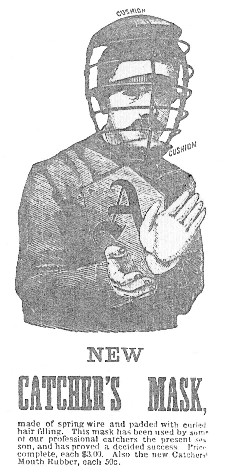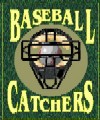| |
|
New York Clipper, Aug. 25, 1877:
INJURIES TO CATCHERS. - It is really surprising, in view of the serious
injuries catchers, facing swift pitching close behind the bat, are
subjected to, that the wire-mask - a perfect protection against such
injuries - is not in more general use among professional catchers. The
idea seems to prevail among a prejudiced few of the fraternity that it is
not plucky or manly to wear the mask. It is nonsensical to run the risk of
such severe injuries simply because a pack of foolish boys may ridicule
you. Look at Clapp of the St. Louis nine, who now lies ill and disabled
with a broken cheek-bone, due entirely to the fact of his not wearing a
protective mask. We regard the Harvard collegian's invention as one of the
best things out for saving a catcher from dangerous injuries. These masks,
improved by substituting an elastic fastening for the strap, can be had at
Peck & Snyders's. (See advertisement at right)
|
|
 |
The Sporting News, Nov. 1, 1890
CHEST PROTECTORS.
The Difficulty of Introducing This New Indisposable Article.
The catcher's breast-protector, or the sheepskin, as it is often
contemptuously referred to, is neither neat nor gaudy, but, like a trick
mule in a kicking match, it gets there just the same. The Cincinnati
Enquirer says on this point:
This most useful piece of base ball paraphernalia had a hard time getting
a foothold. The catchers were slow in adopting it, and the spectators at
first guyed it as baby-play. Clements, the great catcher of the Philadelphia League team
was the first to wear a catcher's protector in a game before a Cincinnati
crowd. He was then back-stopping Jersey Bakely with the Keystones Unions,
of Philadelphia, in 1884. Considerable fun as made of the protector, and
the writer distinctly remembers that it was made the subject of adverse
newspaper comment by one of the best base ball authorities in America. Now
it is different. A catcher's protector is of much importance to a back
stop as are his mask and gloves. In other days a visitor to the dressing
room of a ball team when the players were getting ready for a game did not
need to ask who were the catchers. He could tell them by the black and
blue spots that appeared on various parts of their anatomy, the result of
hard thumps from unruly foul tips. The protector, mask and padded glove
have made the life of a catcher a bed of roses to what it used to be.
Leslie's Illustrated Weekly, Oct. 15, 1914
A Woman's Gift to Baseball
Charles Bennett, famous as a catcher for the noted Detroit team of
1886-1887, delights in telling the story of how his wife made the first
catcher's breast protector. it was a constant source of worry to Mrs.
Bennett to watch her husband acting as a target for the speedy twirlers of
30 years ago and she determined to invent some sort of an armor to prevent
the hot shots from the pitcher playing a tattoo on the ribs of her better
half. After much planning, assisted by practical suggestions from her
husband, she shaped a pad which answered the purpose and which bore some
resemblance to the protector of the present day. In a private tryout it
worked well and Charles, after permitting the ball to strike him repeatedly
without feeling a jar, decided to use it in public. The innovation created
almost as great a sensation as Bresnahan's shin guards, but it made a hit
with the catchers and they were quite ready to follow Bennett's lead.
|
|


